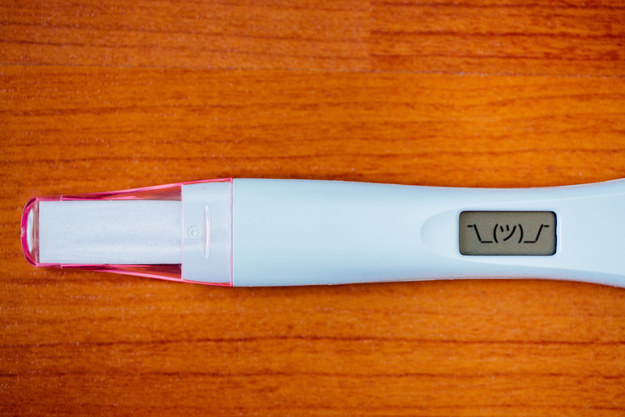If you’re interested in a long-term relationship with your birth control, here are the main things to keep in mind.
Jenny Chang / BuzzFeed
They’re one of the most effective methods of birth control.
http://instagram.com/p/1hGX6KiJxA
IUDs, or intrauterine devices, are more than 99% effective at preventing pregnancy (they’re tied for first with the contraceptive implant — when not including permanent birth control). And unlike other birth control options like the pill, the ring, or condoms, there isn’t a risk for straight-up human error. Your doctor inserts the IUD and it just stays there. It’s a set-it-and-forget-it thing. So if you’re not the best at remembering to take pills or replace your Nuvaring, this might be a great option for you.
There are two main kinds: hormonal IUDs and copper IUDs.
The hormonal IUD is a tiny plastic device that contains the hormone levonorgestrel, which is slowly released into the uterus.
This hormone thickens the cervical mucus, making it a hostile environment for sperm, so they can’t get up there to reach the egg, Dr. Mary Jane Minkin, clinical professor of obstetrics, gynecology, and reproductive science at Yale School of Medicine, tells BuzzFeed Life. It’s also possible that the hormonal IUD sometimes works by stopping the release of an egg or by thinning the lining of the uterus, which would make it harder for a fertilized egg to attach, but these aren’t the primary mechanisms. Most of the time, it just keeps sperm away from your uterus.
There are currently three hormonal IUD options on the market in the U.S.: Mirena (which can stay in up to five years), Skyla (which is a bit smaller and can stay in up to three years), and Liletta (which was just approved by the Food and Drug Administration and can stay in up to three years).
The copper IUD is a tiny device made of plastic and copper, and it’s totally free of hormones.
It works similarly to the hormonal IUD, but instead of levonorgestrel, it’s copper that’s continuously being released into your uterus. The copper is actually toxic to sperm, making it pretty much impossible for the sperm to get to the egg and penetrate it, Dr. Jennifer Gunter, OB-GYN, tells BuzzFeed Life. Again, it’s possible that the copper IUD could sometimes work by preventing a fertilized egg from implanting, but that’s not the primary mechanism. There is currently one copper IUD on the market, Paragard, and it can stay in up to 10 years.
They’re super popular among female doctors.
Female family planning providers are more likely to use the IUD than any other form of birth control, according to a recent study in the journal Contraception.
And they’ve been suggested as a safe and effective birth control method for teens.
They’re not just for women who have already given birth. In 2014, the American Academy of Pediatrics suggested IUDs and implants as “first-line contraceptive choices for adolescents.”
IUDs got a bad rap after an earlier version caused serious health problems.
Back in the 1970s, a previous version of the IUD called the Dalkon Shield was linked to a lot of horrible pelvic infections that reportedly led to infertility and even death. One of the biggest design flaws was that it had a braided, multifilament string that allowed bacteria to climb up into the uterus, Dr. Lisa Perriera, OB-GYN, tells BuzzFeed Life. This is unlike the IUDs we have today, which are actually designed to reduce the rate of infection. But all that bad press and the legal battles made people pretty hesitant about them for a while. Fortunately, we now have safe and effective methods on the market, and many more doctors have been properly trained in the benefits and insertion of IUDs.
IUDs are good options for pretty much anyone who wants lasting pregnancy protection.
The copper IUD is especially good for women who prefer hormone-free birth control, and the hormonal IUD is great for anyone who can’t be on estrogen-containing birth control. The truth is, there are very few people are not good candidates for an IUD, says Minkin.
But obviously, they’re not for everyone.
There are some cases where you should not get the IUD, for instance:
– If you’re pregnant or think you might be pregnant. – If you have any uterine abnormalities that would make it hard for the IUD to stay in place (your doctor can check for this). – If you have acute pelvic inflammatory disease (PID) or a history of PID. – If you have any unexplained genital or uterine bleeding. – If you’ve had postpartum endometritis or an infected abortion in the past three months. – If you have severe liver disease. – If you have breast cancer or a history of breast cancer, you should not get the hormonal IUD, but your doctor might suggest the copper IUD. – If you have any untreated pelvic infections (like chlamydia) or are prone to pelvic infections, you may not be a good candidate for either IUD. Talk to your doctor about this history before getting an IUD. – If you have Wilson’s disease (a rare disorder where copper can accumulate in the body) you cannot get the copper IUD.
This is not an exhaustive list, so make sure to go over a detailed medical history with your doctor before deciding on the IUD.
They don’t actually stop you from ovulating.

If the thought of putting your ovulation on hold kind of freaks you out, the IUD might be a good option. Even the progestin in the hormonal IUD stays mostly in your uterus, with very little getting absorbed into your bloodstream. For some women, these hormones may impact ovulation a little bit in the first year or so, but that will balance out after a while, says Gunter. And if you’re on the copper IUD, it won’t affect ovulation at all.
They start working pretty much immediately.
The copper IUD is the most effective form of emergency contraception, so it starts working as soon as it’s in, says Gunter. The hormonal IUD is also immediately effective if you insert it within seven days of the start of your period, but if you get it inserted any other time, doctors generally recommend using a backup birth control (like a condom) for a week, says Perriera.
And you can get pregnant as soon as you take them out.

IFC / Via tumblr.ifc.com
With both the copper IUD and the hormonal IUD, it’s possible to get pregnant as soon as you get it removed, says Perriera.
Some people report worse periods and cramps on the copper IUD.
You may have heard that some people have nonstop periods or hellish cramps on the copper IUD. Here’s the thing: Research does show that a small percentage of women will get heavier periods on this method, says Gunter. That said, it may also be the case that some women try the copper IUD after trying other hormonal birth control methods, and their periods just seem worse by comparison. Since the copper IUD has no hormones, it won’t make your period lighter or your cramps less awful the way that the pill, the ring, or the hormonal IUD would, says Minkin. If you’re someone who prefers those hormones to even out your cycle, the copper IUD probably wouldn’t be the best fit.
With the hormonal IUD, you may have little to no period.

Comedy Central / Via pampoovye.tumblr.com
After about six months on the hormonal IUD, about half of women report minimal bleeding, with many of them having no period at all, says Gunter. For most people, this is the best benefit of all time, but others might actually miss that monthly reassurance that they’re not pregnant.
But beware: You might bleed A LOT when you first get the hormonal IUD.

Warner Bros / Via changchens.tumblr.com
“With [the hormonal IUD] a significant amount of people will have a lot of irregular bleeding for the first six months,” says Gunter. “Like, you’re ruining a lot of underwear.” But the good news is that the bleeding will gradually decrease over time. And remember that most people have lighter or nonexistent periods after the half-year point.
Insertion is typically quick, but it can be uncomfortable for some and super painful for others.
Most people feel cramping for a day or so, but it’s typically not too bad. Studies show that most women feel mild discomfort, but about a third of women report pain scores of five or more, says Gunter. It might be more uncomfortable if you typically feel pain with pelvic exams or if you have never been pregnant or delivered a baby before, since your cervix might require more dilation.
The best advice is to take some pain medication beforehand and not psyche yourself out about it, says Gunter. “If you’re worried something is going to hurt, it’s more likely to hurt,” she says.
Here’s what it’s actually like to get an IUD:

Keith Brofsky / Getty Images / Via thinkstockphotos.com
We asked Gunter and Minkin to give us a play-by-play so you know exactly what to expect. First your doctor will insert a speculum into your vagina (like when you get a Pap smear). Then they clean the cervix and examine your uterus to see how long it is and what direction it is. Then they load the IUD into a tiny tube like a straw (with the arms collapsed in), and push it through, so it releases into your uterus and the arms open up. Finally, they cut the strings that hang off the end of it, so that you and your partner can’t feel them unless you really go looking for them. The whole process typically only takes a few minutes.
Most doctors will schedule a follow-up visit after your next period so they can make sure everything’s going well. “If something is going to happen, that would be the time frame where we would see it,” says Minkin.
Your doctor will explain how to check for the strings periodically — just to make sure it’s still in place.

Spike Mafford / Getty Images / Via thinkstockphotos.com
Talk to your doctor about how often to do a self-check and how exactly to do it. Minkin explains that feeling for the strings almost feels like using your finger to touch a string on the tip of your nose. It’s very rare for the IUD to slip out of place, but if you don’t feel the strings, you should still call your doctor to see what’s up.
You should get an STI test before you get the IUD.
You’ve probably heard of the association between IUDs and pelvic inflammatory disease (PID). PID is most likely to occur around the time of insertion, and it’s often the result of a sexually transmitted disease, says Minkin. That’s because both chlamydia and gonorrhea can be completely symptomless, and if left untreated they can lead to PID. “If you have an IUD and you get exposed to gonorrhea or chlamydia, you might have a higher risk of an infection that spreads,” says Gunter.
For this reason, it’s crucial to get tested for these infections before you get an IUD and any time you may be at risk while you have an IUD in. Your doctor may test you for chlamydia and gonorrhea right before she inserts the IUD, which is also fine as long as you treat the infections immediately if your test comes back positive, says Minkin.
Remember: IUDs do not protect against HIV and STIs, so use a condom unless you’re in a mutually monogamous relationship and you’ve both been tested recently. Here’s — including which tests you need and how often.
There are a few other serious side effects associated with IUDs, but they’re very rare.

One risk is perforation, which is when the IUD attaches to or goes through the wall of the uterus. It’s very rare, with studies showing it occurs in less than 1% of people with IUDs, says Gunter. It’s slightly more common if you’re breastfeeding, if you have an oddly shaped uterus, or if you just have an inexperienced provider. If you have severe pain during or after insertion, be sure to tell your doctor.
Another risk is expulsion, where the IUD comes out partially or completely. Talk to your doctor if you think this has happened or if you’re experiencing any pain. It’s also possible to develop ovarian cysts with the hormonal IUD, but these typically disappear on their own.
These side effects are all very uncommon, and they’re explained in the prescribing information for your IUD. Even though they’re rare, talk to your doctor about them at your appointment so you know if you’re at risk and what to watch out for.
If you can’t take birth control pills for some reason, you might still be able to use an IUD.
http://instagram.com/p/1hEIPqCJ9p
You doctor may have told you that you’re not a good candidate for the birth control pill because you have a history of blood clots, have migraines with aura, have high blood pressure, are over 35 and smoke, or have other factors that may not mix well with hormonal birth control. If this is the case, you can probably still use one of the IUDs. That’s because neither of these contain estrogen, which is the hormone to blame for these warnings. For this reason, lots of people who can’t take the Pill are actually better off on the hormonal IUD. And if you really can’t be on a hormonal method, the copper IUD would be a great alternative.
Your insurance should cover IUDs, but it might not.
Thanks to the Affordable Care Act, your insurance company ~should~ cover all FDA–approved birth control methods — including the IUD — at no cost (unless you have a grandfathered plan or a plan through a company with an exemption). But without insurance, the IUD can be a very large upfront cost. Be sure to call your insurance company before your appointment so you know exactly what it will cost.
If you get pregnant while you have an IUD (which is incredibly unlikely), it’s more likely to be ectopic.

IUDs have a failure rate of less than 1%, but that still means there’s a very small chance of getting pregnant. If you do get pregnant with an IUD, it’s more likely to be an ectopic pregnancy (one where the embryo implants outside the uterus, often in the fallopian tubes), says Gunter. However, it’s important to note that having an IUD doesn’t raise your risk of having an ectopic pregnancy in general. If you think you may be pregnant, contact your doctor immediately.
IUDs have the highest satisfaction rate of all reversible birth control options.
Obviously not every birth control method will be right for every person, but one thing to keep in mind if you’re considering an IUD is that they have super-high satisfaction rates, says Gunter. In one study in the journal Obstetrics and Gynecology, IUD users had the highest rate of continuation in the first year. Just remember: Every body is different and responds to medication differently. So talk to your doctor and listen to your body to find the best method of contraception for you.


















